Control Food Contamination and Spoilage - Methods and Measures
VerifiedAdded on 2023/06/10
|10
|1951
|464
AI Summary
This article discusses the methods and measures to control food contamination and spoilage. It covers the possible contamination risks and measures to address them. The article also talks about non-conformances, root cause analysis, and food handling operations. It includes tasks related to microbial and chemical testing, and possible contamination risks during ingredient receipt, processing, storage, and transport. The article concludes with a discussion on document control procedures.
Contribute Materials
Your contribution can guide someone’s learning journey. Share your
documents today.
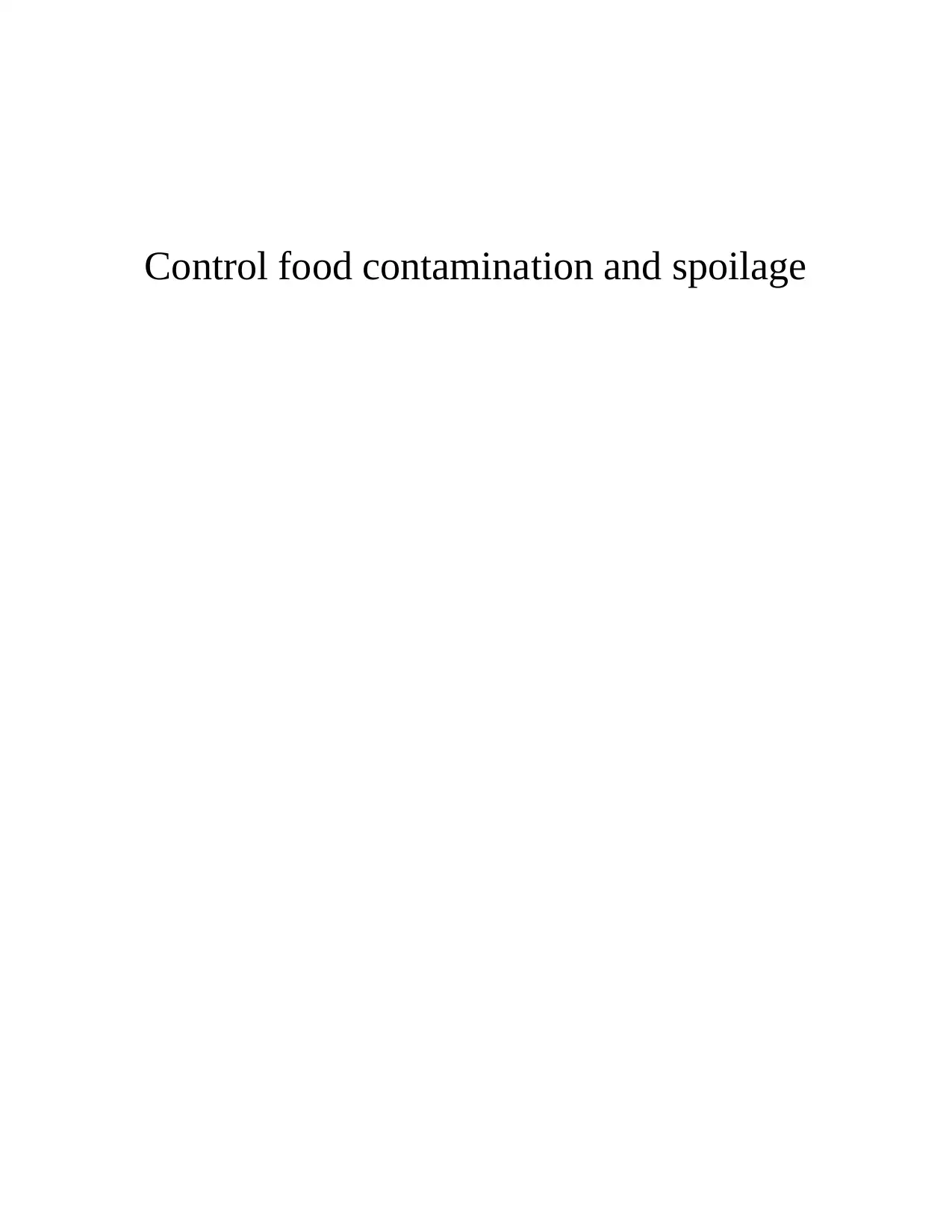
Control food contamination and spoilage
Secure Best Marks with AI Grader
Need help grading? Try our AI Grader for instant feedback on your assignments.
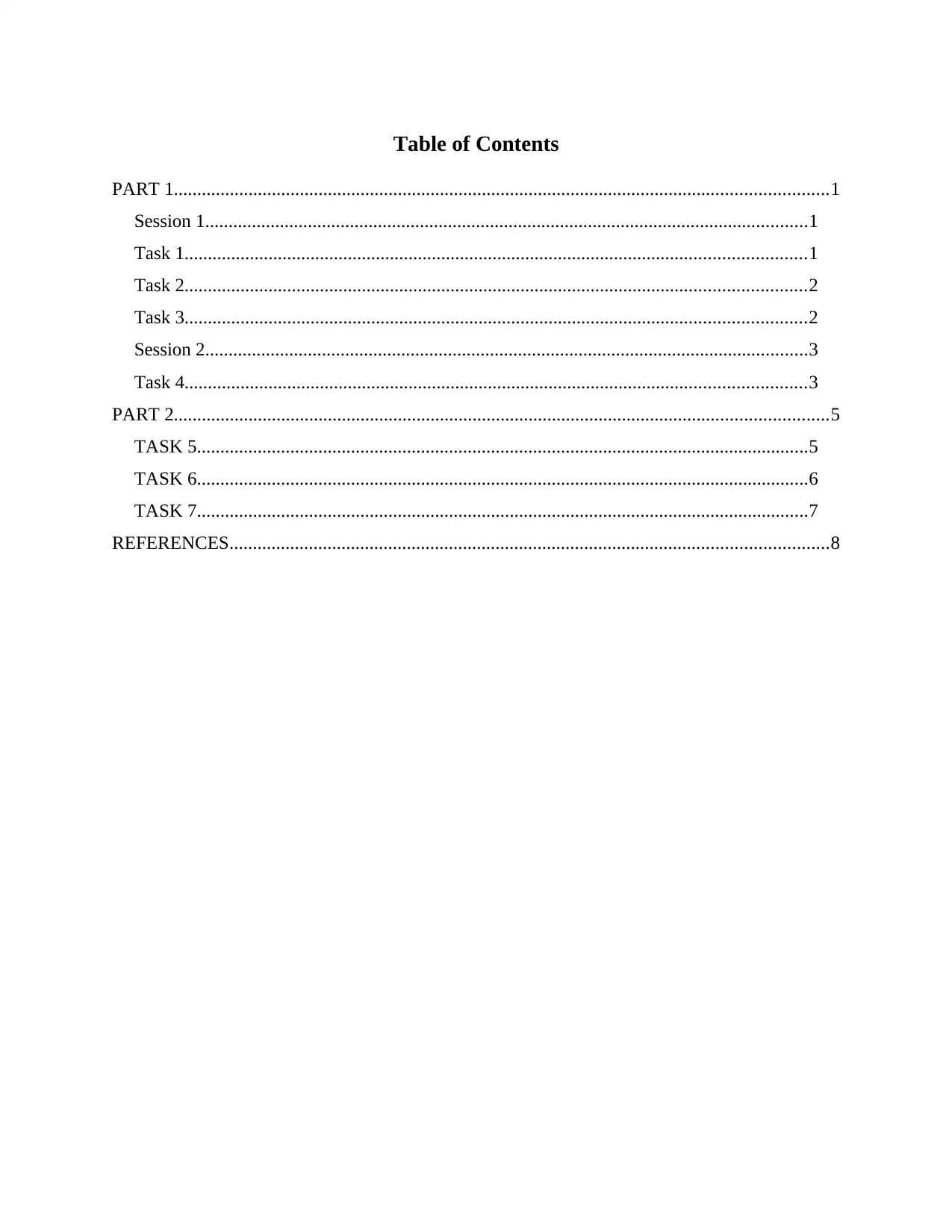
Table of Contents
PART 1............................................................................................................................................1
Session 1.................................................................................................................................1
Task 1.....................................................................................................................................1
Task 2.....................................................................................................................................2
Task 3.....................................................................................................................................2
Session 2.................................................................................................................................3
Task 4.....................................................................................................................................3
PART 2............................................................................................................................................5
TASK 5...................................................................................................................................5
TASK 6...................................................................................................................................6
TASK 7...................................................................................................................................7
REFERENCES................................................................................................................................8
PART 1............................................................................................................................................1
Session 1.................................................................................................................................1
Task 1.....................................................................................................................................1
Task 2.....................................................................................................................................2
Task 3.....................................................................................................................................2
Session 2.................................................................................................................................3
Task 4.....................................................................................................................................3
PART 2............................................................................................................................................5
TASK 5...................................................................................................................................5
TASK 6...................................................................................................................................6
TASK 7...................................................................................................................................7
REFERENCES................................................................................................................................8
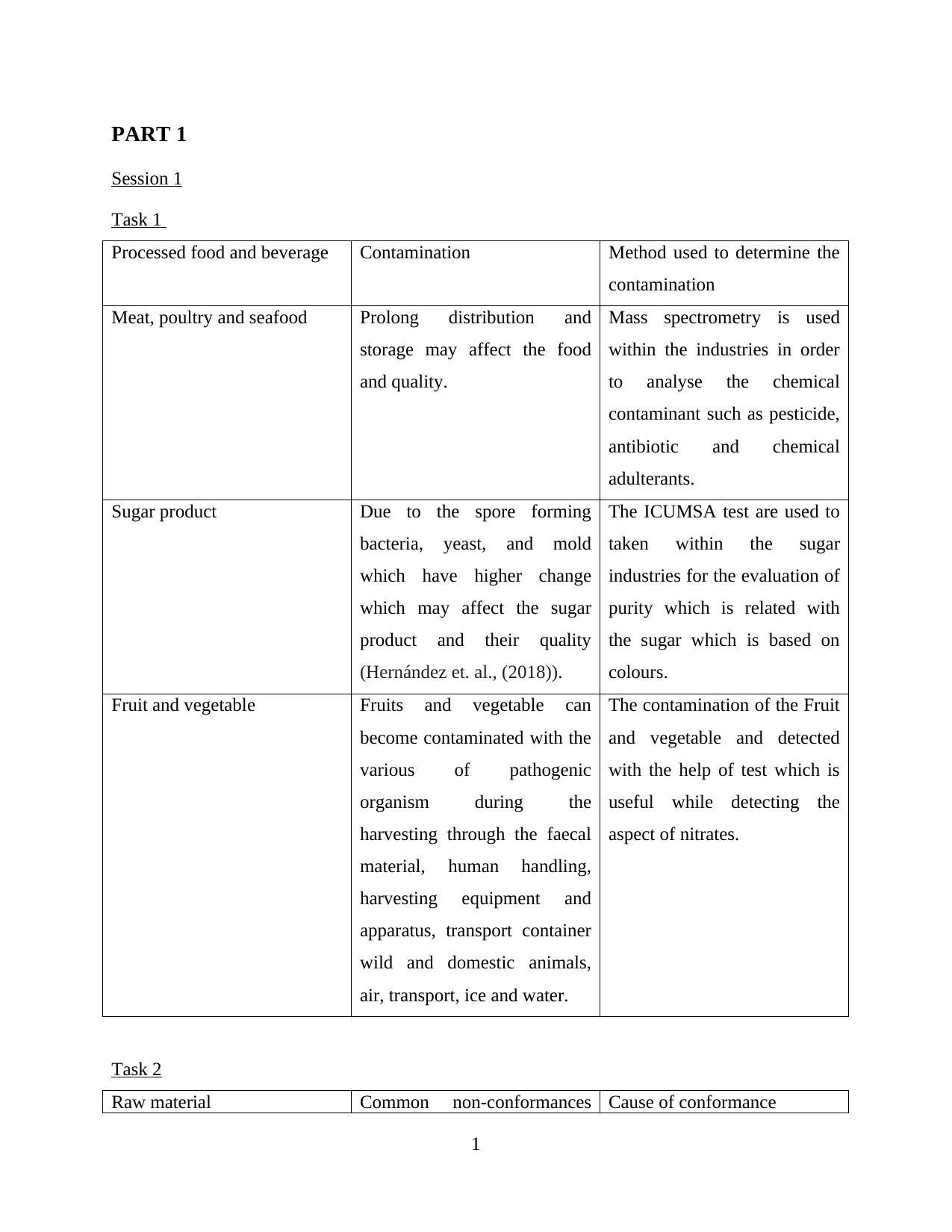
PART 1
Session 1
Task 1
Processed food and beverage Contamination Method used to determine the
contamination
Meat, poultry and seafood Prolong distribution and
storage may affect the food
and quality.
Mass spectrometry is used
within the industries in order
to analyse the chemical
contaminant such as pesticide,
antibiotic and chemical
adulterants.
Sugar product Due to the spore forming
bacteria, yeast, and mold
which have higher change
which may affect the sugar
product and their quality
(Hernández et. al., (2018)).
The ICUMSA test are used to
taken within the sugar
industries for the evaluation of
purity which is related with
the sugar which is based on
colours.
Fruit and vegetable Fruits and vegetable can
become contaminated with the
various of pathogenic
organism during the
harvesting through the faecal
material, human handling,
harvesting equipment and
apparatus, transport container
wild and domestic animals,
air, transport, ice and water.
The contamination of the Fruit
and vegetable and detected
with the help of test which is
useful while detecting the
aspect of nitrates.
Task 2
Raw material Common non-conformances Cause of conformance
1
Session 1
Task 1
Processed food and beverage Contamination Method used to determine the
contamination
Meat, poultry and seafood Prolong distribution and
storage may affect the food
and quality.
Mass spectrometry is used
within the industries in order
to analyse the chemical
contaminant such as pesticide,
antibiotic and chemical
adulterants.
Sugar product Due to the spore forming
bacteria, yeast, and mold
which have higher change
which may affect the sugar
product and their quality
(Hernández et. al., (2018)).
The ICUMSA test are used to
taken within the sugar
industries for the evaluation of
purity which is related with
the sugar which is based on
colours.
Fruit and vegetable Fruits and vegetable can
become contaminated with the
various of pathogenic
organism during the
harvesting through the faecal
material, human handling,
harvesting equipment and
apparatus, transport container
wild and domestic animals,
air, transport, ice and water.
The contamination of the Fruit
and vegetable and detected
with the help of test which is
useful while detecting the
aspect of nitrates.
Task 2
Raw material Common non-conformances Cause of conformance
1
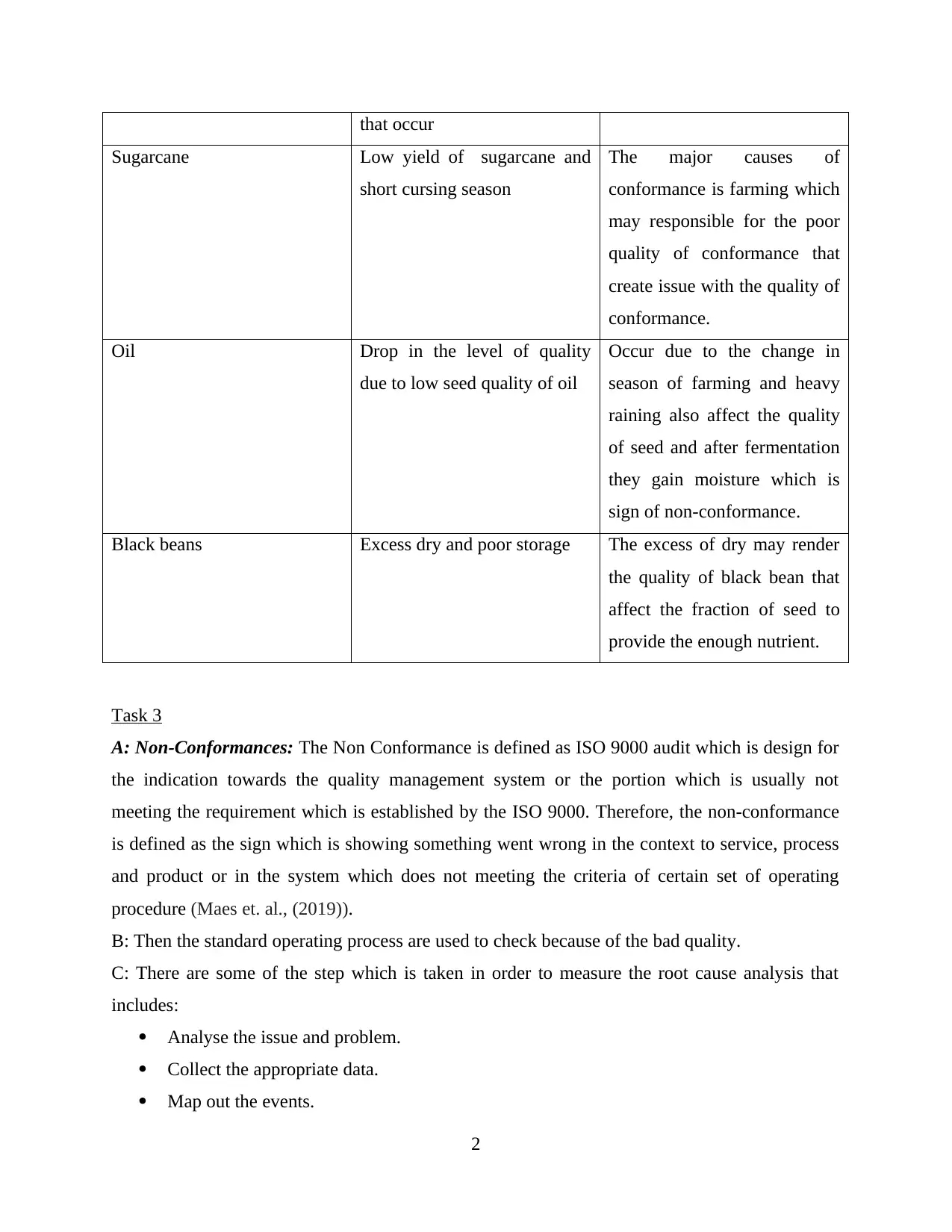
that occur
Sugarcane Low yield of sugarcane and
short cursing season
The major causes of
conformance is farming which
may responsible for the poor
quality of conformance that
create issue with the quality of
conformance.
Oil Drop in the level of quality
due to low seed quality of oil
Occur due to the change in
season of farming and heavy
raining also affect the quality
of seed and after fermentation
they gain moisture which is
sign of non-conformance.
Black beans Excess dry and poor storage The excess of dry may render
the quality of black bean that
affect the fraction of seed to
provide the enough nutrient.
Task 3
A: Non-Conformances: The Non Conformance is defined as ISO 9000 audit which is design for
the indication towards the quality management system or the portion which is usually not
meeting the requirement which is established by the ISO 9000. Therefore, the non-conformance
is defined as the sign which is showing something went wrong in the context to service, process
and product or in the system which does not meeting the criteria of certain set of operating
procedure (Maes et. al., (2019)).
B: Then the standard operating process are used to check because of the bad quality.
C: There are some of the step which is taken in order to measure the root cause analysis that
includes:
Analyse the issue and problem.
Collect the appropriate data.
Map out the events.
2
Sugarcane Low yield of sugarcane and
short cursing season
The major causes of
conformance is farming which
may responsible for the poor
quality of conformance that
create issue with the quality of
conformance.
Oil Drop in the level of quality
due to low seed quality of oil
Occur due to the change in
season of farming and heavy
raining also affect the quality
of seed and after fermentation
they gain moisture which is
sign of non-conformance.
Black beans Excess dry and poor storage The excess of dry may render
the quality of black bean that
affect the fraction of seed to
provide the enough nutrient.
Task 3
A: Non-Conformances: The Non Conformance is defined as ISO 9000 audit which is design for
the indication towards the quality management system or the portion which is usually not
meeting the requirement which is established by the ISO 9000. Therefore, the non-conformance
is defined as the sign which is showing something went wrong in the context to service, process
and product or in the system which does not meeting the criteria of certain set of operating
procedure (Maes et. al., (2019)).
B: Then the standard operating process are used to check because of the bad quality.
C: There are some of the step which is taken in order to measure the root cause analysis that
includes:
Analyse the issue and problem.
Collect the appropriate data.
Map out the events.
2
Secure Best Marks with AI Grader
Need help grading? Try our AI Grader for instant feedback on your assignments.
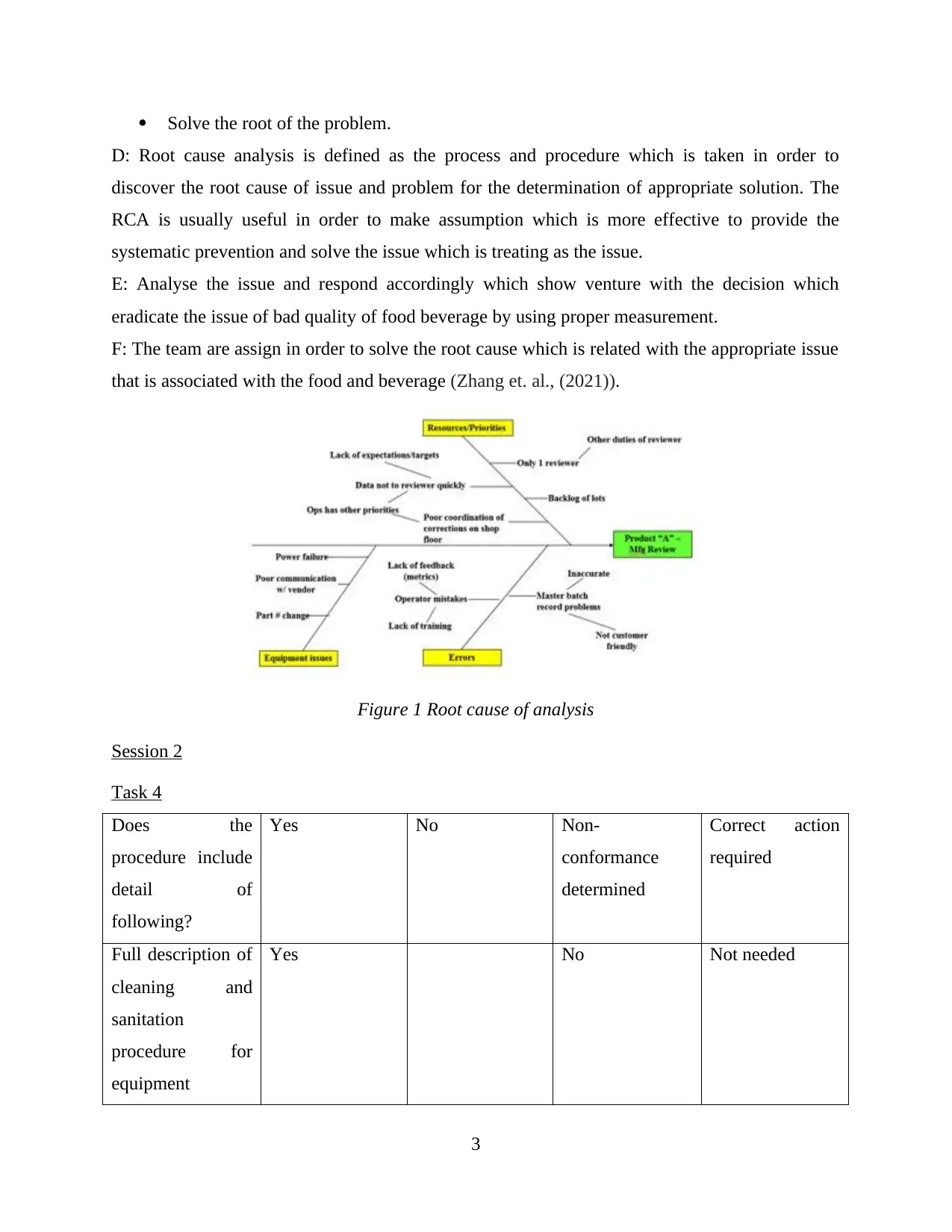
Solve the root of the problem.
D: Root cause analysis is defined as the process and procedure which is taken in order to
discover the root cause of issue and problem for the determination of appropriate solution. The
RCA is usually useful in order to make assumption which is more effective to provide the
systematic prevention and solve the issue which is treating as the issue.
E: Analyse the issue and respond accordingly which show venture with the decision which
eradicate the issue of bad quality of food beverage by using proper measurement.
F: The team are assign in order to solve the root cause which is related with the appropriate issue
that is associated with the food and beverage (Zhang et. al., (2021)).
Figure 1 Root cause of analysis
Session 2
Task 4
Does the
procedure include
detail of
following?
Yes No Non-
conformance
determined
Correct action
required
Full description of
cleaning and
sanitation
procedure for
equipment
Yes No Not needed
3
D: Root cause analysis is defined as the process and procedure which is taken in order to
discover the root cause of issue and problem for the determination of appropriate solution. The
RCA is usually useful in order to make assumption which is more effective to provide the
systematic prevention and solve the issue which is treating as the issue.
E: Analyse the issue and respond accordingly which show venture with the decision which
eradicate the issue of bad quality of food beverage by using proper measurement.
F: The team are assign in order to solve the root cause which is related with the appropriate issue
that is associated with the food and beverage (Zhang et. al., (2021)).
Figure 1 Root cause of analysis
Session 2
Task 4
Does the
procedure include
detail of
following?
Yes No Non-
conformance
determined
Correct action
required
Full description of
cleaning and
sanitation
procedure for
equipment
Yes No Not needed
3
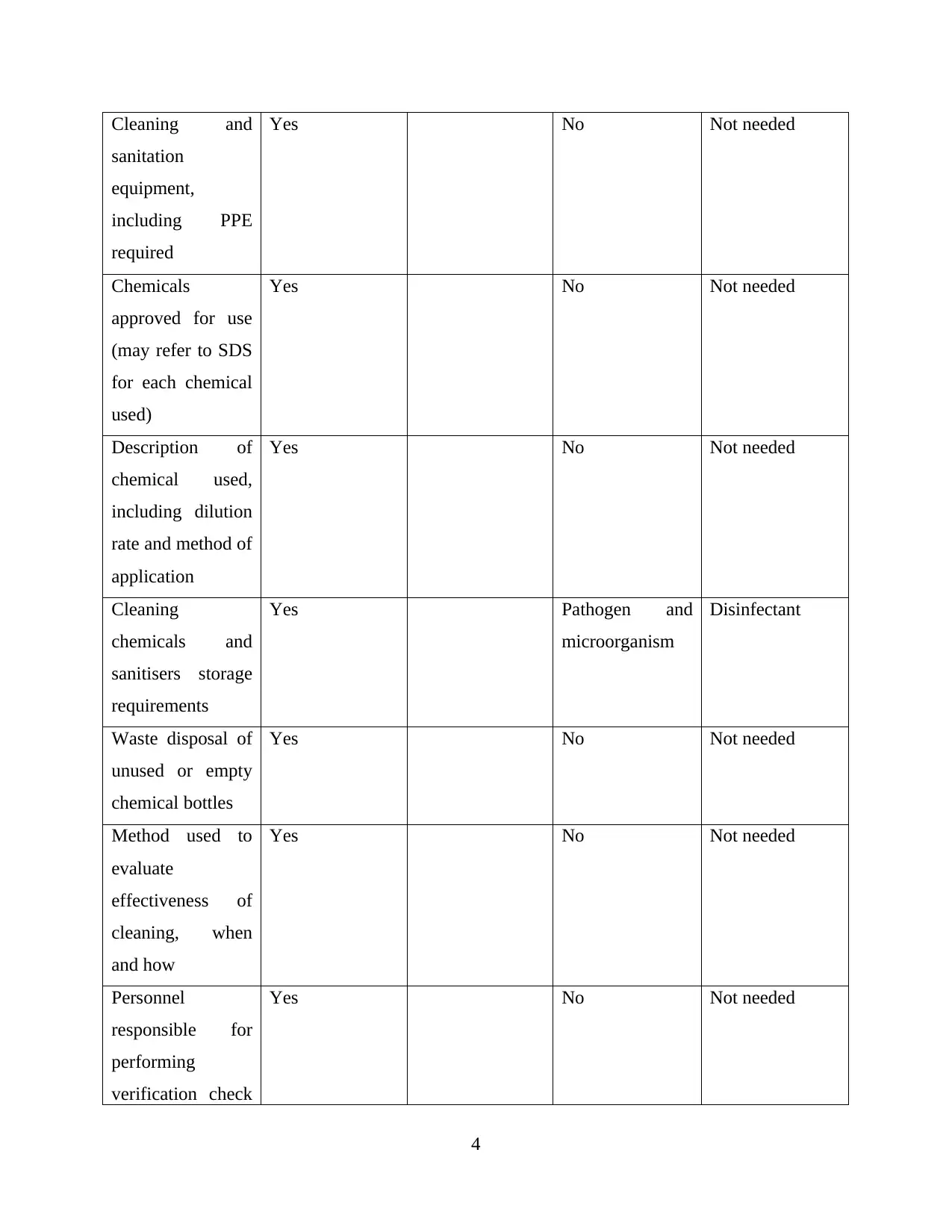
Cleaning and
sanitation
equipment,
including PPE
required
Yes No Not needed
Chemicals
approved for use
(may refer to SDS
for each chemical
used)
Yes No Not needed
Description of
chemical used,
including dilution
rate and method of
application
Yes No Not needed
Cleaning
chemicals and
sanitisers storage
requirements
Yes Pathogen and
microorganism
Disinfectant
Waste disposal of
unused or empty
chemical bottles
Yes No Not needed
Method used to
evaluate
effectiveness of
cleaning, when
and how
Yes No Not needed
Personnel
responsible for
performing
verification check
Yes No Not needed
4
sanitation
equipment,
including PPE
required
Yes No Not needed
Chemicals
approved for use
(may refer to SDS
for each chemical
used)
Yes No Not needed
Description of
chemical used,
including dilution
rate and method of
application
Yes No Not needed
Cleaning
chemicals and
sanitisers storage
requirements
Yes Pathogen and
microorganism
Disinfectant
Waste disposal of
unused or empty
chemical bottles
Yes No Not needed
Method used to
evaluate
effectiveness of
cleaning, when
and how
Yes No Not needed
Personnel
responsible for
performing
verification check
Yes No Not needed
4
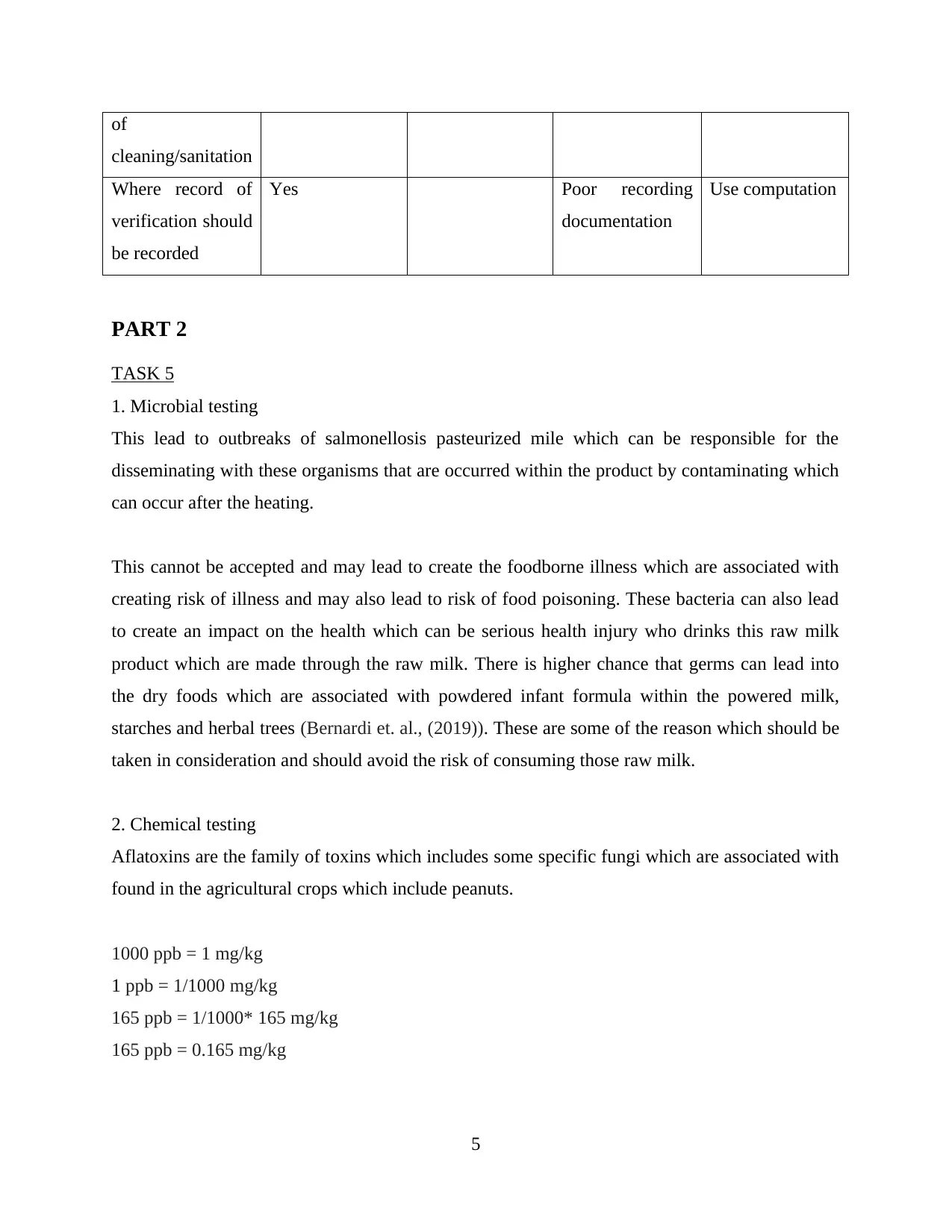
of
cleaning/sanitation
Where record of
verification should
be recorded
Yes Poor recording
documentation
Use computation
PART 2
TASK 5
1. Microbial testing
This lead to outbreaks of salmonellosis pasteurized mile which can be responsible for the
disseminating with these organisms that are occurred within the product by contaminating which
can occur after the heating.
This cannot be accepted and may lead to create the foodborne illness which are associated with
creating risk of illness and may also lead to risk of food poisoning. These bacteria can also lead
to create an impact on the health which can be serious health injury who drinks this raw milk
product which are made through the raw milk. There is higher chance that germs can lead into
the dry foods which are associated with powdered infant formula within the powered milk,
starches and herbal trees (Bernardi et. al., (2019)). These are some of the reason which should be
taken in consideration and should avoid the risk of consuming those raw milk.
2. Chemical testing
Aflatoxins are the family of toxins which includes some specific fungi which are associated with
found in the agricultural crops which include peanuts.
1000 ppb = 1 mg/kg
1 ppb = 1/1000 mg/kg
165 ppb = 1/1000* 165 mg/kg
165 ppb = 0.165 mg/kg
5
cleaning/sanitation
Where record of
verification should
be recorded
Yes Poor recording
documentation
Use computation
PART 2
TASK 5
1. Microbial testing
This lead to outbreaks of salmonellosis pasteurized mile which can be responsible for the
disseminating with these organisms that are occurred within the product by contaminating which
can occur after the heating.
This cannot be accepted and may lead to create the foodborne illness which are associated with
creating risk of illness and may also lead to risk of food poisoning. These bacteria can also lead
to create an impact on the health which can be serious health injury who drinks this raw milk
product which are made through the raw milk. There is higher chance that germs can lead into
the dry foods which are associated with powdered infant formula within the powered milk,
starches and herbal trees (Bernardi et. al., (2019)). These are some of the reason which should be
taken in consideration and should avoid the risk of consuming those raw milk.
2. Chemical testing
Aflatoxins are the family of toxins which includes some specific fungi which are associated with
found in the agricultural crops which include peanuts.
1000 ppb = 1 mg/kg
1 ppb = 1/1000 mg/kg
165 ppb = 1/1000* 165 mg/kg
165 ppb = 0.165 mg/kg
5
Paraphrase This Document
Need a fresh take? Get an instant paraphrase of this document with our AI Paraphraser
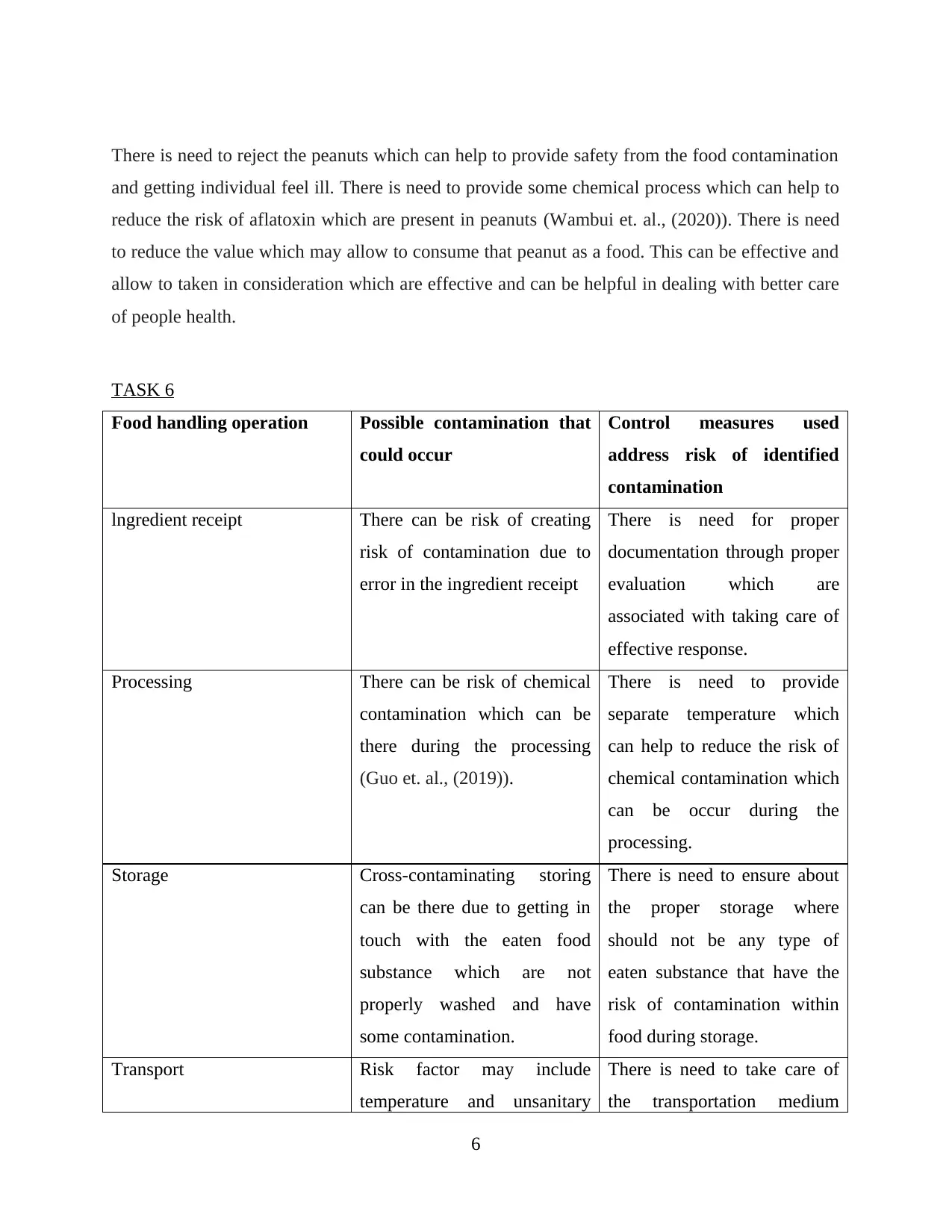
There is need to reject the peanuts which can help to provide safety from the food contamination
and getting individual feel ill. There is need to provide some chemical process which can help to
reduce the risk of aflatoxin which are present in peanuts (Wambui et. al., (2020)). There is need
to reduce the value which may allow to consume that peanut as a food. This can be effective and
allow to taken in consideration which are effective and can be helpful in dealing with better care
of people health.
TASK 6
Food handling operation Possible contamination that
could occur
Control measures used
address risk of identified
contamination
lngredient receipt There can be risk of creating
risk of contamination due to
error in the ingredient receipt
There is need for proper
documentation through proper
evaluation which are
associated with taking care of
effective response.
Processing There can be risk of chemical
contamination which can be
there during the processing
(Guo et. al., (2019)).
There is need to provide
separate temperature which
can help to reduce the risk of
chemical contamination which
can be occur during the
processing.
Storage Cross-contaminating storing
can be there due to getting in
touch with the eaten food
substance which are not
properly washed and have
some contamination.
There is need to ensure about
the proper storage where
should not be any type of
eaten substance that have the
risk of contamination within
food during storage.
Transport Risk factor may include
temperature and unsanitary
There is need to take care of
the transportation medium
6
and getting individual feel ill. There is need to provide some chemical process which can help to
reduce the risk of aflatoxin which are present in peanuts (Wambui et. al., (2020)). There is need
to reduce the value which may allow to consume that peanut as a food. This can be effective and
allow to taken in consideration which are effective and can be helpful in dealing with better care
of people health.
TASK 6
Food handling operation Possible contamination that
could occur
Control measures used
address risk of identified
contamination
lngredient receipt There can be risk of creating
risk of contamination due to
error in the ingredient receipt
There is need for proper
documentation through proper
evaluation which are
associated with taking care of
effective response.
Processing There can be risk of chemical
contamination which can be
there during the processing
(Guo et. al., (2019)).
There is need to provide
separate temperature which
can help to reduce the risk of
chemical contamination which
can be occur during the
processing.
Storage Cross-contaminating storing
can be there due to getting in
touch with the eaten food
substance which are not
properly washed and have
some contamination.
There is need to ensure about
the proper storage where
should not be any type of
eaten substance that have the
risk of contamination within
food during storage.
Transport Risk factor may include
temperature and unsanitary
There is need to take care of
the transportation medium
6
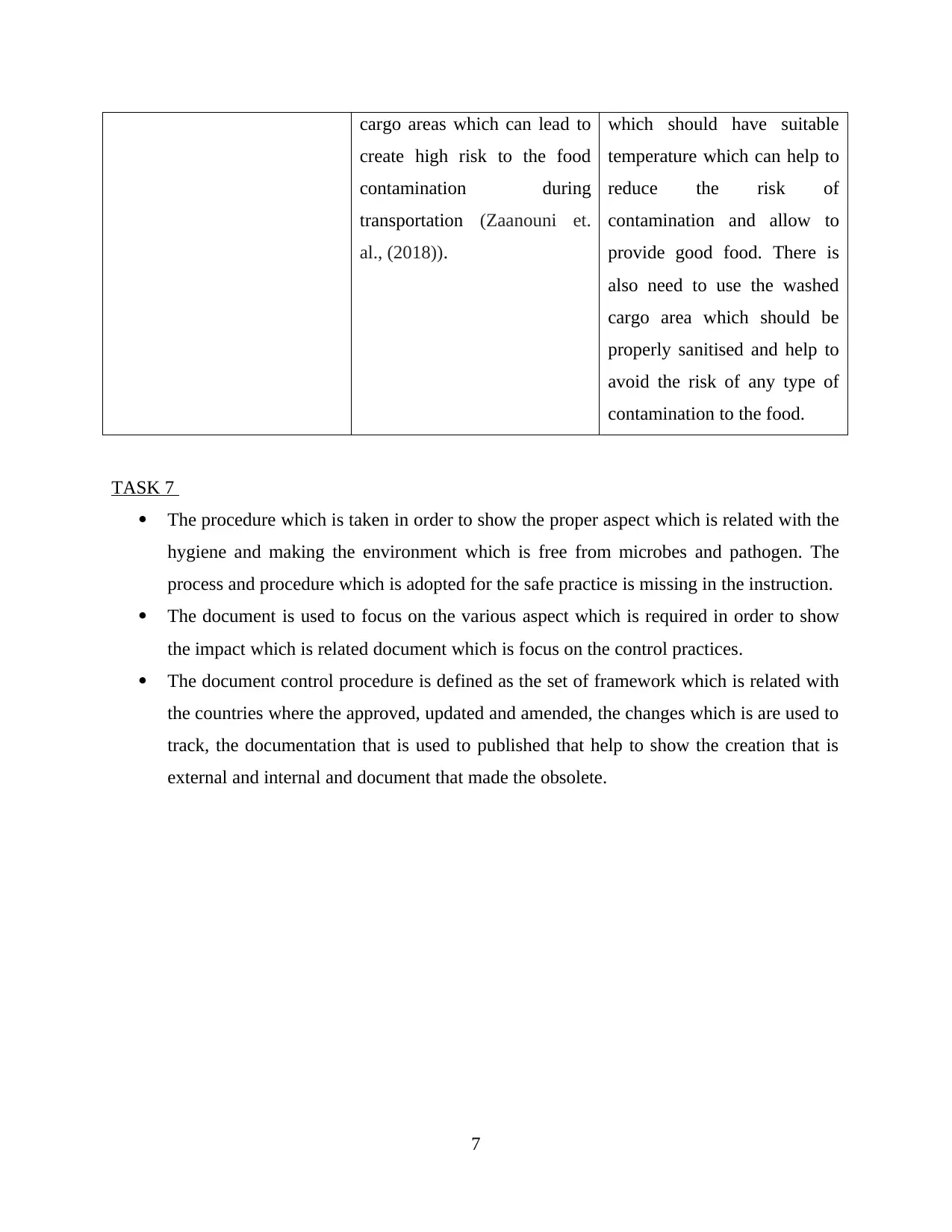
cargo areas which can lead to
create high risk to the food
contamination during
transportation (Zaanouni et.
al., (2018)).
which should have suitable
temperature which can help to
reduce the risk of
contamination and allow to
provide good food. There is
also need to use the washed
cargo area which should be
properly sanitised and help to
avoid the risk of any type of
contamination to the food.
TASK 7
The procedure which is taken in order to show the proper aspect which is related with the
hygiene and making the environment which is free from microbes and pathogen. The
process and procedure which is adopted for the safe practice is missing in the instruction.
The document is used to focus on the various aspect which is required in order to show
the impact which is related document which is focus on the control practices.
The document control procedure is defined as the set of framework which is related with
the countries where the approved, updated and amended, the changes which is are used to
track, the documentation that is used to published that help to show the creation that is
external and internal and document that made the obsolete.
7
create high risk to the food
contamination during
transportation (Zaanouni et.
al., (2018)).
which should have suitable
temperature which can help to
reduce the risk of
contamination and allow to
provide good food. There is
also need to use the washed
cargo area which should be
properly sanitised and help to
avoid the risk of any type of
contamination to the food.
TASK 7
The procedure which is taken in order to show the proper aspect which is related with the
hygiene and making the environment which is free from microbes and pathogen. The
process and procedure which is adopted for the safe practice is missing in the instruction.
The document is used to focus on the various aspect which is required in order to show
the impact which is related document which is focus on the control practices.
The document control procedure is defined as the set of framework which is related with
the countries where the approved, updated and amended, the changes which is are used to
track, the documentation that is used to published that help to show the creation that is
external and internal and document that made the obsolete.
7
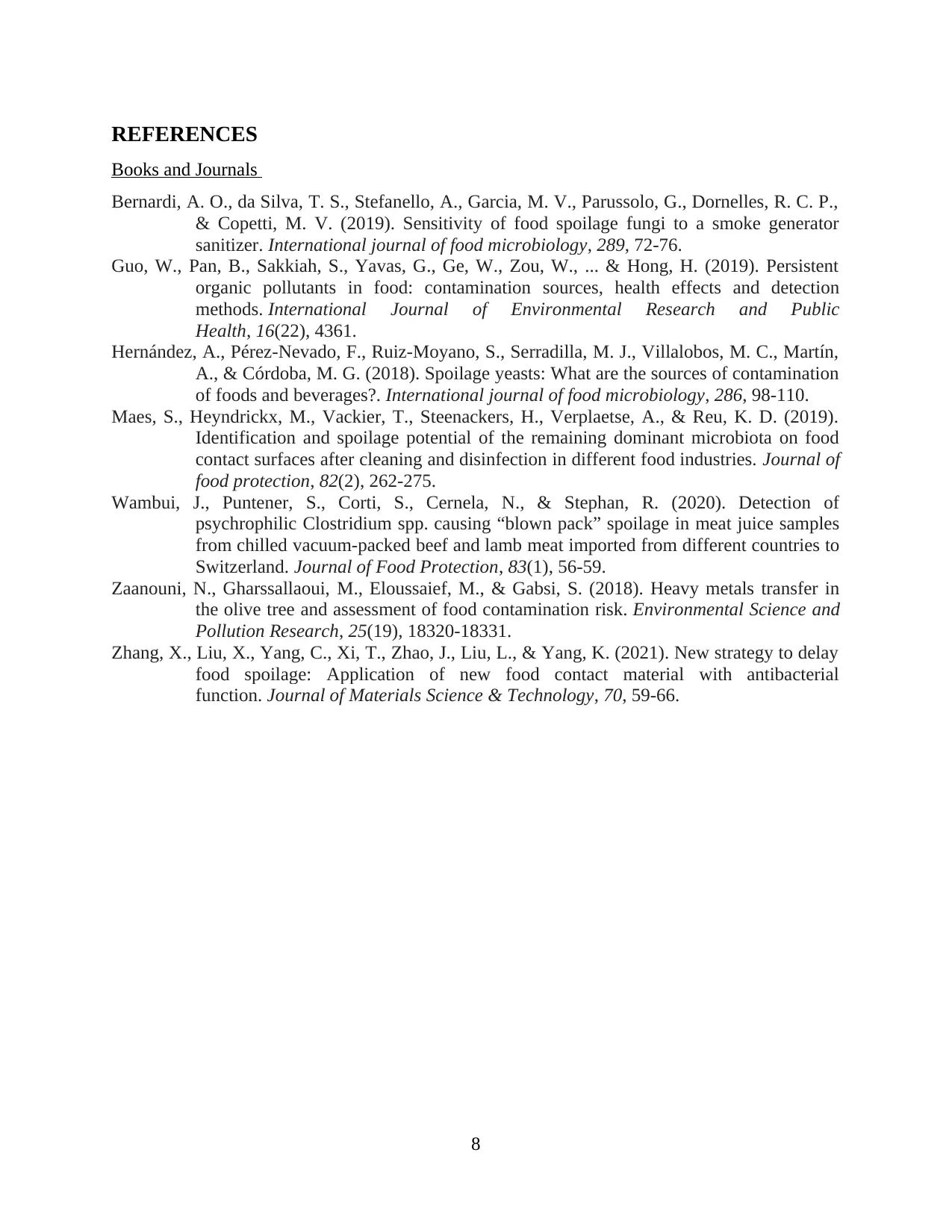
REFERENCES
Books and Journals
Bernardi, A. O., da Silva, T. S., Stefanello, A., Garcia, M. V., Parussolo, G., Dornelles, R. C. P.,
& Copetti, M. V. (2019). Sensitivity of food spoilage fungi to a smoke generator
sanitizer. International journal of food microbiology, 289, 72-76.
Guo, W., Pan, B., Sakkiah, S., Yavas, G., Ge, W., Zou, W., ... & Hong, H. (2019). Persistent
organic pollutants in food: contamination sources, health effects and detection
methods. International Journal of Environmental Research and Public
Health, 16(22), 4361.
Hernández, A., Pérez-Nevado, F., Ruiz-Moyano, S., Serradilla, M. J., Villalobos, M. C., Martín,
A., & Córdoba, M. G. (2018). Spoilage yeasts: What are the sources of contamination
of foods and beverages?. International journal of food microbiology, 286, 98-110.
Maes, S., Heyndrickx, M., Vackier, T., Steenackers, H., Verplaetse, A., & Reu, K. D. (2019).
Identification and spoilage potential of the remaining dominant microbiota on food
contact surfaces after cleaning and disinfection in different food industries. Journal of
food protection, 82(2), 262-275.
Wambui, J., Puntener, S., Corti, S., Cernela, N., & Stephan, R. (2020). Detection of
psychrophilic Clostridium spp. causing “blown pack” spoilage in meat juice samples
from chilled vacuum-packed beef and lamb meat imported from different countries to
Switzerland. Journal of Food Protection, 83(1), 56-59.
Zaanouni, N., Gharssallaoui, M., Eloussaief, M., & Gabsi, S. (2018). Heavy metals transfer in
the olive tree and assessment of food contamination risk. Environmental Science and
Pollution Research, 25(19), 18320-18331.
Zhang, X., Liu, X., Yang, C., Xi, T., Zhao, J., Liu, L., & Yang, K. (2021). New strategy to delay
food spoilage: Application of new food contact material with antibacterial
function. Journal of Materials Science & Technology, 70, 59-66.
8
Books and Journals
Bernardi, A. O., da Silva, T. S., Stefanello, A., Garcia, M. V., Parussolo, G., Dornelles, R. C. P.,
& Copetti, M. V. (2019). Sensitivity of food spoilage fungi to a smoke generator
sanitizer. International journal of food microbiology, 289, 72-76.
Guo, W., Pan, B., Sakkiah, S., Yavas, G., Ge, W., Zou, W., ... & Hong, H. (2019). Persistent
organic pollutants in food: contamination sources, health effects and detection
methods. International Journal of Environmental Research and Public
Health, 16(22), 4361.
Hernández, A., Pérez-Nevado, F., Ruiz-Moyano, S., Serradilla, M. J., Villalobos, M. C., Martín,
A., & Córdoba, M. G. (2018). Spoilage yeasts: What are the sources of contamination
of foods and beverages?. International journal of food microbiology, 286, 98-110.
Maes, S., Heyndrickx, M., Vackier, T., Steenackers, H., Verplaetse, A., & Reu, K. D. (2019).
Identification and spoilage potential of the remaining dominant microbiota on food
contact surfaces after cleaning and disinfection in different food industries. Journal of
food protection, 82(2), 262-275.
Wambui, J., Puntener, S., Corti, S., Cernela, N., & Stephan, R. (2020). Detection of
psychrophilic Clostridium spp. causing “blown pack” spoilage in meat juice samples
from chilled vacuum-packed beef and lamb meat imported from different countries to
Switzerland. Journal of Food Protection, 83(1), 56-59.
Zaanouni, N., Gharssallaoui, M., Eloussaief, M., & Gabsi, S. (2018). Heavy metals transfer in
the olive tree and assessment of food contamination risk. Environmental Science and
Pollution Research, 25(19), 18320-18331.
Zhang, X., Liu, X., Yang, C., Xi, T., Zhao, J., Liu, L., & Yang, K. (2021). New strategy to delay
food spoilage: Application of new food contact material with antibacterial
function. Journal of Materials Science & Technology, 70, 59-66.
8
1 out of 10
Your All-in-One AI-Powered Toolkit for Academic Success.
+13062052269
info@desklib.com
Available 24*7 on WhatsApp / Email
![[object Object]](/_next/static/media/star-bottom.7253800d.svg)
Unlock your academic potential
© 2024 | Zucol Services PVT LTD | All rights reserved.